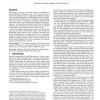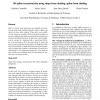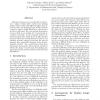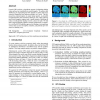126
click to vote
EGH
2010
Springer
14 years 11 months ago
2010
Springer
We modify the Reyes object-space shading approach to address two inefficiencies that result from performing shading calculations at micropolygon grid vertices prior to rasterizati...
135
click to vote
TOG
2002
15 years 17 days ago
2002
In this paper, we present a system for interactive computation of global illumination in dynamic scenes. Our system uses a novel scheme for caching the results of a high quality p...
113
click to vote
IVS
2006
15 years 28 days ago
2006
Very early in the object recognition process the human visual system extracts shading information. While shading can enhance the visibility of structures, it can have a negative i...
121
click to vote
IVC
2008
15 years 28 days ago
2008
In this work, we propose an original method of resolution of the shape from shading problem, which is accurate and converges with a few iterations. It relies on two simple ideas. ...
107
Voted
CGF
2008
15 years 1 months ago
2008
This paper introduces a framebuffer level of detail algorithm for controlling the pixel workload in an interactive rendering application. Our basic strategy is to evaluate the sha...
123
click to vote
CGF
2010
15 years 1 months ago
2010
In the style of binary shading, shape and illumination are depicted using two colors, typically black and white, that form coherent lines and regions in the image. We formulate th...
130
click to vote
MVA
1998
15 years 2 months ago
1998
This paper proposes a new method for reconstruction a shape of skin surface replica from shading image sequence taken with dierent light source directions. Since the shading image...
113
click to vote
ICVGIP
2004
15 years 2 months ago
2004
Shape from Shading (SFS) is one of the most extensively studied problems in Computer Vision. However, most of the approaches only deal with Lambertian or other specific shading mo...
120
click to vote
SIGGRAPH
1998
ACM
15 years 5 months ago
1998
ACM
Over the years, there have been two main branches of computer graphics image-synthesis research; one focused on interactivity, the other on image quality. Procedural shading is a ...
94
Voted
SIGGRAPH
2010
ACM
15 years 5 months ago
2010
ACM
Current GPUs perform a significant amount of redundant shading when surfaces are tessellated into small triangles. We address this inefficiency by augmenting the GPU pipeline to...




